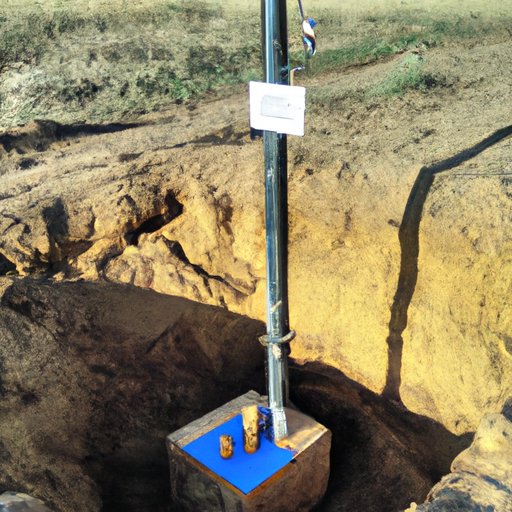Introduction
A sand point well is a type of shallow well that is used to access groundwater located near the surface of the Earth. It is a cost-effective and relatively easy way to provide water for households, farms, and livestock. The well is typically installed by driving a metal pipe into the ground with a heavy hammer or hydraulic pounder. The pipe is then filled with a special filter material to keep out sediment and other contaminants.

An Overview of How Sand Point Wells Work
The components of a sand point well include a metal drive pipe, a screened filter, and a check valve. The drive pipe is inserted into the ground and driven in with a heavy hammer or hydraulic pounder. The screened filter is attached to the bottom of the pipe and acts as a barrier to keep out sediment and other contaminants. A check valve is installed at the top of the pipe to prevent water from flowing back up the pipe when it is not in use.
Once the drive pipe is in place, water is pumped up through the pipe and through the filter. This removes any debris or particles that may be present in the water. The filtered water is then collected in a storage tank or cistern for use.

Benefits of a Sand Point Well Over Other Types of Wells
Sand point wells offer several advantages over other types of wells. They are typically less expensive to install than traditional drilled wells, making them an attractive option for those on a tight budget. They are also much easier to install than a traditional drilled well, as they don’t require specialized equipment or expertise to complete the job.
In addition, sand point wells require much less maintenance than other types of wells. Since they are only a few feet deep, they are less prone to clogging or other issues that can affect deeper wells. This reduces the amount of time and money spent on repairs and upkeep.
The Cost of Installing a Sand Point Well
The cost of installing a sand point well will vary depending on the size of the well and the materials used. Generally speaking, the cost of installation should be between $1,000 and $3,000. This includes the cost of the materials, the labor to drive the pipe into the ground, and any necessary permits.
In addition to the initial costs of installation, there will also be ongoing costs associated with maintaining the well. These costs include regular inspections and repairs, as well as the cost of replacing any broken or worn components.

Maintenance Requirements for Sand Point Wells
Regular maintenance is essential for keeping a sand point well in good working order. This includes inspecting the pipe and filter on a regular basis to ensure they are free of debris and other contaminants. Additionally, it’s important to clean the filter periodically to remove any buildup of sediment or other materials.
In addition to regular inspections and cleaning, it’s also important to repair any broken or worn components. This includes replacing the check valve if it becomes damaged or worn over time. Additionally, the drive pipe should be checked for signs of corrosion or wear and replaced if necessary.

Troubleshooting Common Sand Point Well Problems
If you experience any issues with your sand point well, it’s important to troubleshoot and identify the cause before attempting to fix the problem. Common issues include low water pressure, leaking pipes, and poor water quality.
Low water pressure can be caused by a blockage in the pipe or a faulty check valve. Leaking pipes can be caused by corrosion or cracks in the pipe. Poor water quality can be caused by debris or contaminants in the filter.
How to Select the Right Site for a Sand Point Well
When selecting a site for a sand point well, it’s important to consider the type of soil in the area. Sandy soils are ideal for this type of well, as they allow for easy insertion of the drive pipe. It’s also important to understand any local regulations that may apply to the installation of a sand point well.
Finally, it’s important to research the water sources in the area to ensure that the water is safe to drink. If the water contains contaminants, a more complex filtration system may be required to make it safe for drinking.
Exploring the History of Sand Point Wells
Sand point wells have been used since ancient times to access groundwater near the surface of the Earth. In the United States, they were widely used during the early 20th century, particularly in rural areas where traditional drilled wells were too expensive or difficult to install. Today, they remain a popular choice for providing water for homes, farms, and livestock.
Conclusion
Sand point wells are an affordable and easy-to-install option for accessing groundwater. They are less expensive than traditional drilled wells and require much less maintenance. However, it’s important to understand the cost of installation, ongoing maintenance requirements, and potential problems that may arise before deciding to install one. With proper care and maintenance, a sand point well can provide an abundant source of clean water for many years to come.
(Note: Is this article not meeting your expectations? Do you have knowledge or insights to share? Unlock new opportunities and expand your reach by joining our authors team. Click Registration to join us and share your expertise with our readers.)
